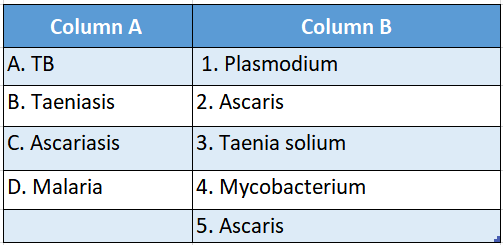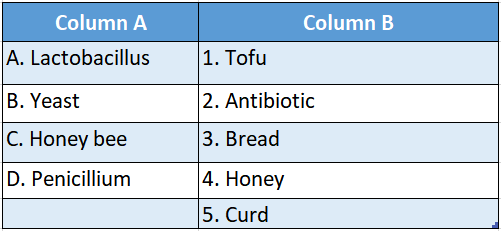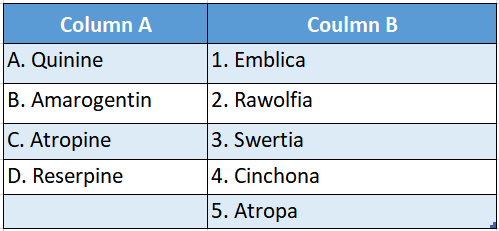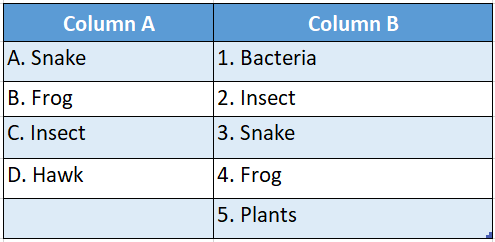Chapter 1 Interdependence Of Organisms And Environment Review Questions MCQs
Question 1. In any community, various populations live
- independently
- dependently
- defencelessly
- interdependently
Answer: 4. interdependently
Question 2. An example of a stem tuber is
- Potato
- Onion
- Ginger
- Ol
Answer: 1. Potato
Read And Learn More: WBBSE Solutions For Class 6 School Science
Question 3. An example of a root tuber is
- Potato
- Quinine
- Sweet potato
- Beet
Answer: 2. Quinine
Question 4. The following constituent is used as roughage
- Sucrose
- Maltose
- Cellulose
- Starch
Answer: 3. Cellulose
Question 5. The flower(s) that is consumed include(s)
- Cauliflower
- Broccoli
- Both
- None
Answer: 3. Both
Class 6 Science Question Answer WBBSE
Question 6. Which of the following is obtained from animals?
- Cotton
- Wool
- Hessian bag
- Coins
Answer: 2. Wool
Question 7 _________is called the ‘sweeper bird.’
- vulture
- owl
- crow
- heron
Answer: 3. crow
Question 8. Which substance is not obtained from plants?
- paper
- gum
- Quinine
- curd
Answer: 4. curd
Question 9. Erythromycin is obtained from
- bacteria
- plants
- animals
- fungi
Answer: 1. bacteria
Question 10. Resin is commonly associated with
- Gnetum
- Banyan
- Neem
- Pinus
Answer: 2. Banyan
Question 11. The following alkaloid helps in the reduction of high blood pressure
- Amarogentin
- Reserpine
- Quinine
- Atropine
Answer: 2. Reserpine
Question 12. The process of photosynthesis utilizes
- CO2
- Water
- Both
- Oxygen
Answer: 3. Both
Class 6 Science Question Answer WBBSE
Question 13. Clownfish develop a symbiotic association with
- Sea star
- Sea anemone
- Sea urchin
- Hydra
Answer: 2. Sea anemone
Question 14. Cuscuta is a
- Root parasite
- Stem parasite
- Leaf parasite
- None of them
Answer: 3. Leaf parasite
Question 15. Ascariasis is the other name for an infection caused by
- Pinworm
- Tapeworm
- Roundworm
- Liver fluke
Answer: 2. Tapeworm
Question 16. An association between two individuals where both are benefitted is called
- predation
- competition
- parasitism
- symbiosis
Answer: 4. symbiosis
Question 17. The microbes present in curd is
- Lactobacillus
- Rhizobium
- Streptomyces
- Saccharomyces
Answer: 1. Lactobacillus
Class 6 Science Question Answer WBBSE Chapter 1 Interdependence Of Organisms And Environment Fill In The Blanks
Question 1. The edible stem of Amorphophallus is called __________
Answer: corm
Question 2. The edible part of celery is __________
Answer: petiole
Question 3. The largest plant fibre is __________
Answer: ramie
Question 4. Hemp comes from __________
Answer: Cannabis
Question 5. __________ is cultivated in cropland to increase nitrification.
Answer: Azolla
Question 6. Tannin comes from the stem of __________
Answer: Emblica
Question 7. The alkaloid used against malaria is __________
Answer: quinine
WBBSE Class 6 Science Question Answer
Question 8. The oxygen liberated in photosynthesis comes from __________
Answer: water
Question 9. Tapeworm from pork is also called __________
Answer: Taenia solium
Question 10. The red-coloured flower is mostly pollinated by __________
Answer: bird
Question 11. Aspergillus is a __________ parasite.
Answer: facultative
Question 12. Carrot has a high amount of __________
Answer: vitamin A
Question 13. Streptomycin is produced from __________
Answer: Streptomyces
Question 14. Curd production is brought about by __________
Answer: Lactobacillus
Question 15. A unicellular fungus causing fermentation is __________
Answer: yeast
Chapter 1 Interdependence Of Organisms And Environment Fill In The Blanks Identify As ‘True’ Or ‘False”
Question 1. Radish is an edible root.
Answer: True
Question 2. The most widely consumed grain in the world is wheat.
Answer: False
Question 3. Linen is made from the stem of Flax.
Answer: True
Question 4. The evolution of carbon dioxide during the production stage is responsible for the porous texture of the bread.
Answer: True
Class 6 Science Question Answer WBBSE
Question 5. Berry is a fleshy fruit.
Answer: True
Question 6. Ants and bees have a symbiotic association.
Answer: False
Question 7. Frog predates reptiles.
Answer: False
Question 8. Herons and Rhinoceros have a symbiotic association.
Answer: True
WBBSE Class 6 Science Question Answer
Question 9. Puccinia causes black stem rust of wheat.
Answer: True
Question 10. Mycobacterium causes the disease of TB.
Answer: True
Question 11. Scavenger hunt and kill animals for their consumption.
Answer: False
Question 12. Pigs act as a natural scavengers.
Answer: True
Question 13. Lactobacillus convert sucrose to lactic acid.
Answer: False
Question 14. Penicillium is a common mould.
Answer: True
Question 15. Streptomyces produces an antitubercular drug.
Answer: True
Class 6 WBBSE Science Question Answer Chapter 1 Interdependence Of Organisms And Environment Match The Columns

Answer: A-4,B-3,C-5,D-1

Answer: A-5,B-3,C-4,D-2

Answer: A-4,B-3,C-5,D-2

Answer: A-4,B-2,C-5,D-3
Chapter 1 Interdependence Of Organisms And Environment Answer In Words Or A Sentence
Question 1. Name the plant which produces fibre from leaves.
Answer: Agave sisalana leaf fibres are used to make rope.
Question 2. Name four underground modified stems.
Answer: Tuber of potato, bulb of onion, rhizome of ginger and corm of ol.
Question 3. What are the conditions for bat pollination?
Answer: The flower should be nocturnal and they are large in size.
Question 4. How are banyan seeds dispersed?
Answer: Since the banyan fruits are edible and red in colour, they are consumed by birds and afterwards, the seeds come out with their excreta in a different place.
Class 6 WBBSE Science Question Answer
Question 5. Which organs are damaged by malaria?
Answer: The organs affected by malaria are the liver and spleen apart from blood.
Question 6. What type of relation is exhibited by the Hermit crab and Sea anemone?
Answer: They exhibit symbiosis.
Question 7. How is tannin helpful for plants?
Answer: Tannin stored in the plant body protects them from fungal infection.
Question 8. How is latex useful to plants?
Answer: Latex comes out in the event of mechanical injury and protects the plant from secondary infection.
WBBSE Class 6 Science Question Answer
Question 9. Give two examples of medicinal plants.
Answer: Cinchona and Rauwolfia.
Question 10. How do animals act as scavengers?
Answer: Animals like crows, and pigs feed on different types of waste products and organic matter and clean the environment, and thus they are called natural scavengers.
Question 11. Name two birds which use holes in trees as their nests.
Answer: Woodpeckers and owls.
Question 12. Name the vitamins found in cod liver oil.
Answer: Vitamin A and Vitamin D.
Question 13. Name two animal fibres.
Answer: Wool and Silk.
Question 14. What is an antibiotic?
Answer: An antibiotic is a type of antimicrobial substance that inhibits the growth of or destroys microorganisms and combat bacterial infections.
Question 15. Name a marine natural scavenger.
Answer: White shark
Chapter 1 Interdependence Of Organisms And Environment Short Answer Type Questions
Question 1. What is the importance of ramie fibres?
Answer: Ramie fibres are long durable fibres which are woven to make light clothes that are not easily stained.
Question 2. What is the source and use of resin?
Answer: Resin is produced from the stem of the Pinus. It is used as a polishing agent and also as an organic solvent for paints.
Question 3. What are the features of insect-pollinated flowers?
Answer: The flowers have bright colour, pollen grains are sticky, petals provide a seat for the insects and they have nectaries.
Question 4. How alkaloids are important as medicines?
Answer: Alkaloids are useful against different diseases: quinine is useful to treat malaria, amelogenin is useful to treat Kalazar etc.
Class 6 WBBSE Science Question Answer
Question 5. What is streptomycin?
Answer: Streptomycin is an antibiotic produced by Streptomyces, which is useful against tuberculosis bacteria.
Question 6. Why is cotton cloth useful to treat an injury?
Answer: Cotton cloth gauze is formed of loosely woven threads. It is a very good absorbent and thus, useful to treat injury.
Question 7. What is silk fibre?
Answer: Silk fibre is a protein secretion from the silk gland of silkworms, which solidifies as a thread when they come in contact with air.
The colour and texture of the silk thread depend on the type of food consumed by the silkworm.
Question 8. What is meant by Taeniasis?
Answer: Taeniasis means tapeworm infection, which might occur due to the consumption of contaminated pork or beef.
Question 9. What is meant by a facultative parasite?
Answer: Facultative parasite normally survives in a decaying substance as a saprophyte, but may act as opportunistic parasite invading higher organism, e.g. Aspergillus.
Question 10. How do aphids and ants live together?
Answer: The aphid and ant follow a unique symbiotic relationship.
The aphids feed on plant sap and produce the excreta called honeydew, which is consumed by ants, while aphids remain well protected within the ant’s nest.
Question 11. Bread has many pores – explain why?
Answer: The dough made of wheat or flour is fermented by yeast to produce bread. Carbon dioxide and alcohol are also produced in this process.
Carbon dioxide helps in the swelling of the dough. Later mild heating causes the carbon dioxide to be liberated thereby causing the porous texture of the bread.
Question 12. What is the utility of vitamin A in our body?
Answer: Vitamin A is a potential source of retinol which helps in the synthesis of rod cells in the retina of the human eye that are responsible for low-light vision.
Question 13. Which organisms are called scavengers of nature and why? Are carnivores scavangers?
Answer: Scavengers are the organisms which consume dead and decaying remains of plants and animals that have either died of natural reasons or have been killed by another carnivore.
Ex. crow, vultures etc.
Almost none of the carnivores in the world are pure scavengers since carnivores (such as tigers) hunt and kill animals for their own consumption.
Question 14. Explain two roles of microbes in the production of medicines.
Answer: Microbes are useful sources of medicines like antibiotics.
Penicillin is produced from the green mould Penicillium notatum. Antibiotics like streptomycin and erythromycin are produced from streptomyces bacteria.
Question 15. How is curd prepared?
Answer: Curd is prepared by mixing lukewarm milk with a portion of curd prepared earlier. A bacteria called Lactobacillus lactis exists in the already-prepared curd.
Class 6 WBBSE Science Question Answer
This bacteria helps in the fermentation of the lactose sugar of milk to lactic acid.
After a few hours, some other changes take place in the milk and it is transformed into curd. The lactic acid formed prevents further growth of pathogenic bacteria in curd.

